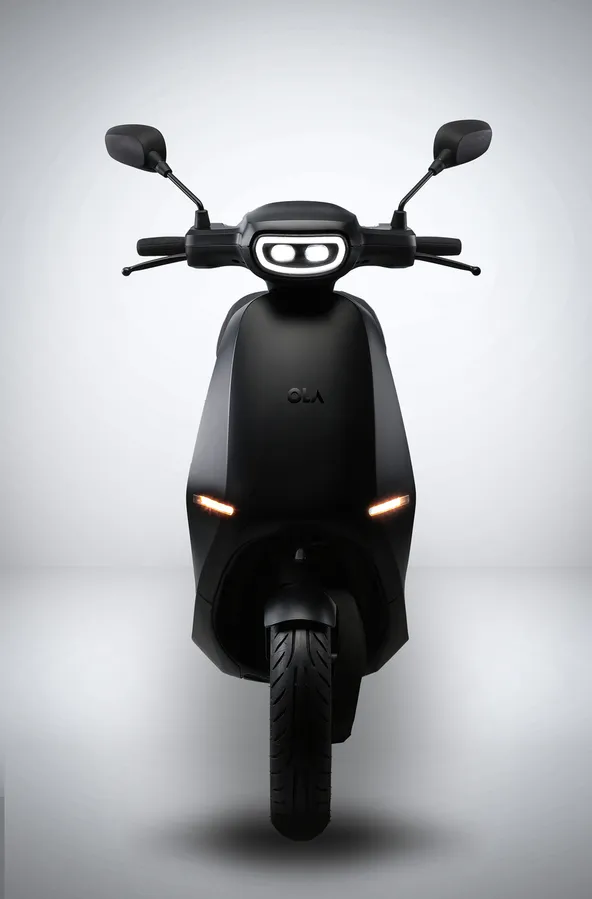Every Friday is a busy day for Bhavish Aggarwal, Co-founder and Group CEO, Ola. Starting early at 6 am from Bengaluru, Bhavish drives close to 140 km to Sipcot in Krishnagiri District, Tamil Nadu, to visit the construction of Ola’s fully automated EV factory.
A unicorn within a year of its inception, Ola Electric’s ambitions are clearly high – to put Ola Electric Vehicles on the global map.
While the stone laying ceremony for the construction of the world’s largest two-wheeler factory took place just a few weeks ago, the 500-acre land has now been cleared and large trucks and teams of people are working at break-neck speed to complete the first phase of the factory by June 2021.

Bhavish Aggarwal at the site
Drones, cranes, and humans seem to work in tandem. Every activity is being closely monitored, so that inefficiencies can be checked right away. Taking a walk through some parts of the land, Bhavish tells YourStory that the work on the land is happening 24X7, and each segment is being built simultaneously.
“We have tight schedules and timelines, considering we want to start with two million units from June this year,” says Bhavish. The 500 acre land will be an integrated manufacturing space for battery, welding, general assembly, paint shop, motor, finished goods, and test track supplier park.

Ola Electric’s new factory site
AI and automation
A 90 percent automated facility, the core technology and engineering will be controlled by Ola. The company will also be designing, engineering, and manufacturing its own battery pack, vehicle computers, and the software components that would be going into the factory. Calling it an automotive technology company, Bhavish said Ola Electric will be fully automated.
The team envisions the factory to run on AI and automation. “The AI engine monitors the work in the factory and keeps optimising the work. There is a lot of integrated AI. The factory itself has been built in a sustainable manner to ensure there is better use of energy and tech. We have also planned a vertical forest in the middle of the factory,” says Varun Dubey, Head of Marketing, Ola.
The factory will be powered by Ola’s own proprietary AI engines and tech stacks that will be integrated into all its systems. Ola Electric will also be hiring over 10,000 people to work in the factory.
“This will be the world’s largest scooter factory. Ola Electric aims to bring India to the world stage of this electrification revolution,” said Bhavish while addressing a press briefing at the Ola Future Factory land space.
“When we started doing this, we realised that building a factory is a full-engineering project. Building the plant in itself is a massive engineering challenge, and we are looking at building an automated, AI-driven factory,” says Bhavish.

Bhavish Aggarwal with the scooter
A dream in the making
This is not Ola’s first rodeo at getting into electric vehicles as a form of mass mobility. Close to three-and-a-half years ago, Ola had announced a large project in Nagpur to build a mass mobility ecosystem. Ola had then tied up with the likes of Mahindra and Mahindra, Tata Motors, Kinetic, BYD, and TVS among others.
While Ola could have continued to tie up with multiple partners, it realised that to make EV a part of everyday norm and consumption, the scale was the key.
Bhavish explains, “The dream of building a sustainable, electric mass mobility ecosystem isn’t an overnight one. We wanted to assess how EVs will perform in India and how the existing EV technology is in India. The Nagpur pilot was a multi-modal pilot. We had a charging network and a swapping network. The pilot taught us that there was a need to build a complete ecosystem.”
“We knew that it would take a different kind of effort. Most players were working around the fringes. And to bring sustainability in mobility, you need to work on a large scale and that is when we started thinking of Ola Electric. It all started 3.5 years back.”
The mobility company is now planning to sell electric scooters, three-wheelers, and cars, which will also mark its entry into the auto retail sector. The company said it is planning to build 10 million scooters by 2022, and its Phase 1 will have an annual capacity of two million, which will be ready by June 2021. In short, Ola Electric aims to build a complete electric vehicle ecosystem in the next few years.
Bhavish explains, even when he and Ankit Bhati started the Ola journey 10-years ago, they were looking to build mobility for the future.
“The biggest disruption then was the shared-mobility kind of business model, which we executed and scaled, and today we are one of the top shared mobility companies in the world. But our bigger ambition has always been to build sustainable, safe, and accessible mobility for everybody. And that isn’t just restricted to mobility services,” says Bhavish.

Prototype of the Ola Electric scooter
Reimagining the vehicle
The idea is to solve the problem fundamentally – from the supply-chain and core technologies to the R&D talent. Bhavish explains the idea is to create the scale. “This business cannot be built by selling 2,000 vehicles in a year, it needs an industry disruption,” says Bhavish.
He explains the team doesn’t believe that shared mobility will replace personal mobility. People will have different mobility needs, and some will be fulfilled with shared mobility.
“But in future, people will have private ownership of cars or vehicles, and the nature of those vehicles will evolve and they will become sustainable. Electric vehicles will be more connected, and the concept of a vehicle will change. The electrification technology is not just a means of making the vehicle clean, it’s a means of reimagining what a vehicle can be. It can increasingly drive itself. Or maybe we can have a different type of space arrangement inside, connected to the cloud.”
“There is a lot of change that will happen in the next 10 years, and hence it is important to plan for that scale from day one,” adds Bhavish.

Putting India on the world EV map
Ola’s electric scooter will have a complete AI engine, with two batteries of 10.5 to 11 kgs that can be easily swung on your shoulder like a backpack. The prototype scooter is designed, engineered, and built in-house, is connected to the cloud, can make and receive calls, is connected to an app, and can also play music. Ola Electric is also building multiple charging stations and the batteries can also be charged at home.
Bhavish explains their biggest advantage is the scale they are looking at. Most of the larger players like Tesla or Neo are working on the premium segment. But Bhavish says the mass of the world aren’t luxury products or large SUVs and sedans.
“Nobody in the world is solving the meat of the market. We believe we have a very unique opportunity to put India on the world map by focusing on urban mobility vehicles and building electrification, and making India the world’s hub for electric vehicle production of urban mobility,” he says.
He adds the team is starting with two-wheelers because it is the quintessential urban mobility product in India. The team, however, already has plans for motorbikes, four-wheelers, and three-wheelers.
Building a global business
The year 2021 seems to have sparked India’s electric vehicle revolution. With a total budget of $1.41 billion, the FAME II programme has been deployed over three years from April 1, 2019, to benefit the EV sector.
Elon Musk’s Tesla recently announced its entry into India and TVS Motor Company Ltd acquired shared mobility startup Intellicar Telematics Pvt Ltd earlier this month. Ather Energy’s factory at Hosur, Tamil Nadu, is also working to bring more electric two-wheelers on the road.
There is also Ultraviolette that is building premium motorbikes in the EV segment. Most of these vehicles are priced between Rs 1.5 lakh and Rs 3 lakh. While Ola didn’t reveal what the scooters will be priced at, it said the pricing will be competitive. The company is yet to reveal the range of the scooters.
“Our ambition is to build a global business, and we are building a global first business. This factory is going to be exporting a lot of products as well,” says Bhavish.
It will cater to customers not only in India, but markets around the world, including Europe, Asia, Latin America, and more. The company is gearing up to launch the first range of highly anticipated electric scooters in the coming months.










